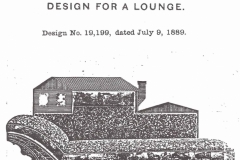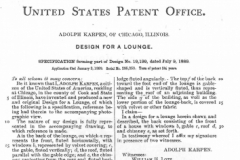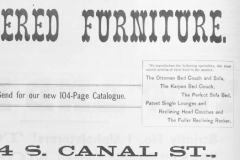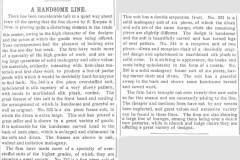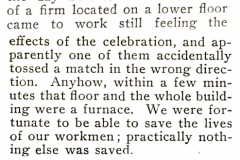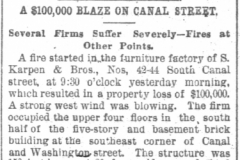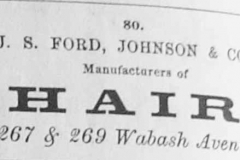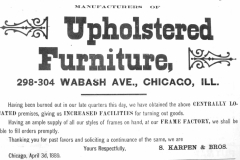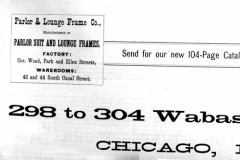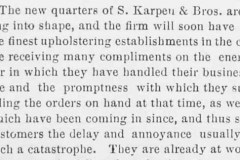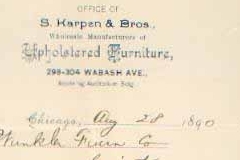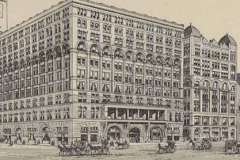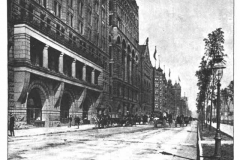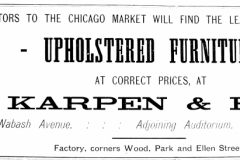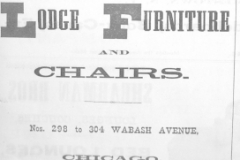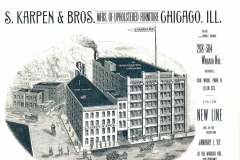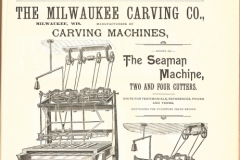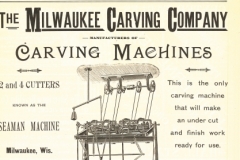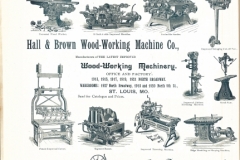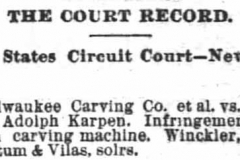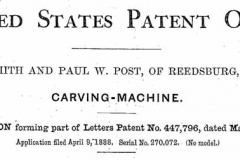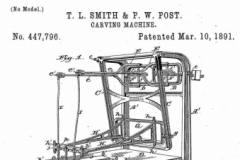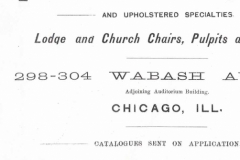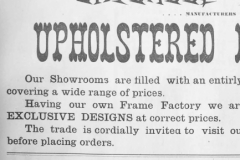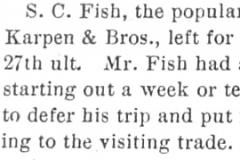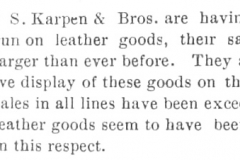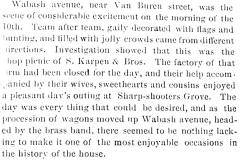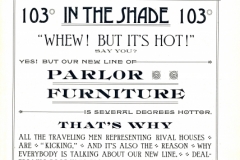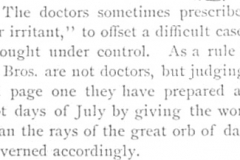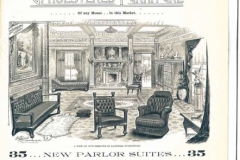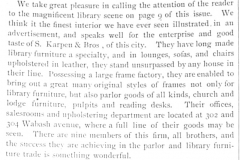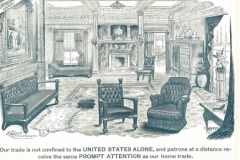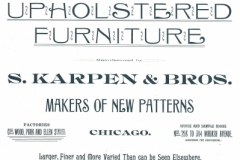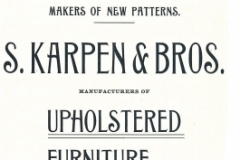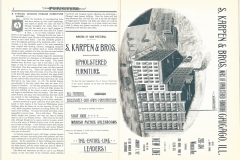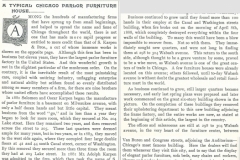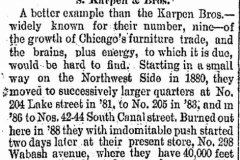Overcoming a Tragedy: 1889-1891
“Never mind!” I said to my brothers when the smoke cleared; “the milk is spilled. There is no use crying.” I have tried to take disappointments big and little in that spirit.—Solomon Karpen in Neil Clark, “How Nine Brothers Built Up a $10,000,000 Business,” Forbes, August 1, 1926, 11.
One of the early Karpen patented pieces was an unusual lounge design—the back consisted of house, including a chimney. We do not know if that design was ever manufactured.
A trade journal wrote in detail describing the 1889 Karpen line:
Just when the company achieved such heady success, tragedy struck the company. Decades later Solomon in an interview for Forbes Magazine recalled what happened:
On April 4, 1889, the Chicago Tribune reported the fire that consumed the Karpen business on April 3rd:
The story of the large fire was copied in newspapers all over the country—for instance in Dallas, Texas, Washington DC, and Boston, Massachusetts. The loss was valued at $38,000 of which $20,000 was covered by insurance; some newspapers and the trade newspaper erroneously reported the loss as $70,000 with light insurance.
True to Solomon’s story, a furniture trade journal reported that they “immediately leased the premises at 396 Wabash avenue, recently vacated by J. S. Ford, Johnson & Co., and will be ready to ship in about ten days. Their frame factory was fortunately well stocked with frames, which are being sent to the new location, and the upholsterers were to have begun work on the 8th, so there will be but little delay in filling orders.” [2] The trade newspaper wrote that “they were only stopped four days by the fire, and orders are coming in more rapidly than before. They are putting on additional men.”[3]
Using the trade press, Karpen Bros. reacted rapidly to assure dealers and buyers that its business would not suffer from the fire:
The brothers’ quick response was noted:
The new location they chose was in an upscale area on Wabash Avenue, close to Congress Parkway and near Van Buren Street. The Auditorium Building, a Romanesque Revival theater built in 1887 by the very prestigious architectural firm of Adler & Sullivan[8] adjoined the new site. Almost the entire building “is occupied by the furniture trade. As every firm in the building are leaders in their respective lines, the display is large enough and fine enough to use up about a days’ time of even the quickest buyer.”[9] Just a few months later, it was reported: “it was to certain extent an experiment when Karpen & Bros. moved up to their present location, No. 298 Wabash Avenue, but the experiment has proved a success. Their present quarters are all that could be desired.”[10] “The central location of their new factory and salesroom will insure them increased attention from the visiting trade.”[11]
The “showrooms, which are on the first and second floors, are among the finest in the trade, and the abundant light shows that the firm are desirous of inviting the closest inspection.”[12] They have 30,000 square feet of show rooms. [13] “In their showroom devoted to parlor goods, they have over 100 different suits [suites] on the floor, and in no case are there two samples of the same pattern of frame, and when it is considered that each of these frames is offered in from two to four different woods, and that each of these is upholstered in perhaps a dozen different fabrics, it will be seen that the selection of goods on their floor is almost unlimited. The line comprises goods from the lowest price upwards, but in medium and finer goods the selection is particularly fine.”[14] “On the main or street floor is displayed the line of leather upholstered goods, which is much larger than ever before and contains many new features.” [15]
Advertisements in the trade papers invited buyers to their new showrooms:
The Karpens learned from their tragedy. At the same time, Karpen Bros. had been making extensive alterations at their parlor frame factory: a four-story addition 65 feet x 75 feet to the existing four-story building 65 feet x 125 feet at a cost of $4,000.[18] In addition, the factory had a three-story warehouse 40 feet x 75 feet.[19] Karpen Bros. also fit up the enlarged plant and its new factory with automatic sprinklers manufactured by Grinnell Automatic Sprinklers of Chicago.[20] “The sprinkler system will automatically extinguish the fire with the least possible damage to the stock.”[21] “The great feature of the Grinnell sprinkler is the fact that it has never been known to leak, as the form of its construction is such that the greater the pressure on the valves, the tighter it becomes, while other sprinklers are certain to leak if the pressure reaches a certain limit. This is a matter of great importance to furniture manufacturers.”[22]
Report on Machinery by The Chicago Furniture Manufacturers Industry. (“Chicago Furniture Exposition,” July 6-August 6, 1891. Chicago History Museum.)
As part of its expansion, the company looked to modernize furniture manufacturing machinery. In 1891, Solomon, Oscar, and Adolph were sued for patent infringement by two Wisconsin inventors who were making improvements in the carving machine:
In July 1891, Karpen Bros. completed an additional factory building on North Wood street, adjoining their frame factory. [23] They bought the land for $6,000, and the construction cost $30,000.[24] It was 85 feet x 125 feet and seven floors,[25] bringing its total space to 90,000 square feet.[26] The building, to be used for upholstering, had first-class freight elevators, complete electric lighting, and a two hundred fifty horsepower engine.[27][28] The firm moved its entire manufacturing department to the new factory.[29] Its factory employed more than 250 men.[30]
The brothers were never complacent; they continually entered new markets.[32] Furnishing fraternal lodges, club libraries, and churches with chairs, pulpits and stands was a growing business as new churches and lodges for the Masons and Elks were being constructed or enlarged throughout the country. Again the key to its success was its frame factory because it could accommodate the special requests of each organization. [33] It published a special catalog for these lines and displayed these pieces on one side of the main floor of its salesrooms. [34][35][36] “The designs cover all grades from the best to the cheapest, and all are in late and artistic patterns.”[37] Orders were, for example, comprised of “a complete outfit for six lodge rooms, all of it to be of a very fine grade,”[38] and they have fitted out some of the finest lodges in the West. [39] They supplied a large quantity of “fine club-house furniture” for the new East Saginaw Club-House at East Saginaw (near Detroit), Michigan. [40] According to the trade papers, “the church and lodge chairs and pulpits turned out by them are unexcelled in the country. In fact, this house has an enviable reputation for this class of furniture, and is sought after by church and other societies, as well as dealers, when in need of something first-class and reliable.” “Their next catalogue will show some radical departures in the matter of style.”[41][42]
Everything was coming together well as reported in the trade papers:
“This is now the only firm in Chicago that manufacture their own frames. This ought to prove a decided advantage to them, and it enables them to offer a line of designs that cannot be obtained elsewhere.”[45]Their line was called “one of the finest lines ever shown in the city….The entire line is one of which the firm may justly feel proud, and one which will do much, to maintain the reputation of Chicago as a leading furniture market.”[46]
“It is surprising how large a proportion of the visiting trade placed orders with S. Karpen & Bros., but all occasion for surprise vanishes when one inspects their line for they have made the greatest effort in the history of the house to offer a line of parlor furniture in attractive and artistic designs, and one which at the same time could be sold at a reasonable price and still afford a fair margin of profit. Their order book is the best indication of their success.”[47] “S. Karpen & Bros. are booking a big list of substantial orders from the buyers who are in town, in addition to what they are constantly receiving by mail, which in itself constitutes a considerable item. The lines they are showing entitles them to a large share of the business, and buyers evidently appreciate the fact.”[48]
This rapid rise of course brought criticism, but the trade papers supported their endeavors. “How do they do it?” is the question that is agitating the competitors of S. Karpen & Bros. How they can turn out such well made, desirable parlor goods at the prices asked is a conundrum that is making more trouble for their rivals than the revision of the tariff. But the fact remains that they are showing one of the largest and finest lines of desirable parlor goods in the country and are selling them at prices that, at least, keep them from getting dusty on the floor.”[49]
These successful years[50] were celebrated in the typical fashion of the times—the annual company picnic. A trade paper describe the event that took place in Palo Park, 19 miles southwest of the city center:
In the early 1890s Karpen promoted its higher profile with full page advertisements in the furniture trade papers. The trade papers commented on these advertisements:
A full page advertisement depicting an ornate living room brought favorable commentary in a furniture trade journal. It is not clear whether this signed drawing was really Karpen furniture because the exact same drawing was used by another company a month later.
For the first time, in 1891, Karpen Bros. created a slogan. “Makers of New Patterns,” unique to its advertisements and used it in all its advertisements onwards for many years.
From the early years of the business, the Karpen brothers understood that they needed to cooperate with other Chicago furniture manufacturers to promote Chicago as the most important furniture market destination in the country; to deal with the railroads regarding freight costs;[51] and to negotiate with labor. Therefore, in February 1888, it was Adolph who made motions (that were unanimously approved) to form a permanent organization to be named “The Chicago Furniture Manufacturers Association.” S. Karpen & Bros. was one of the thirty-one founding members.[52] A trade newspaper, under the headline “Chicago Alive to its Interests. The furniture dealers are at last waked up [sic],” explained its purpose: “While it will never be a trust as is being organized in oil, coal, and other commodities, it will bring together the furniture men and result in harmonious action, and promises literary and technical exchange of views at these monthly gatherings. The manufacturers can stand considerable fraternizing without injury, as there is not the perfect feeling of confidence between them that is expected to develop through association in these meetings.”[53]
Adolph represented the company in this project and immediately took a leadership role. In 1888 an organizational meeting was called when the railroad classifications [rate schedules] for furniture had been doubled thus threatening to shut the Chicago manufacturers out of the eastern [i.e. New York] market.[54] At the meeting, Adolph forcefully pushed for immediate action: “on motion of Mr. Karpen…it was unanimously agreed to form a permanent organization, and again on motion of Mr. Karpen it was unanimously agreed that the name of the permanent organization should be “‘The Chicago Furniture Manufacturers Association.’”[55][56] The next year, the Association elected Adolph secretary of the association;[57] [58][59][60][61] among his duties was to take and sign the minutes of the monthly meetings.[62] He was re-elected secretary in 1891.[63]
Adolph then moved to the national stage. In 1889, according to the National Furniture Manufacturers Association, there were 6,000 furniture manufacturing establishments, employing 62,000 workers, producing goods valued at $83 million.[64] The national association was composed of more than 17 associations and 944 members.[65] The delegates selected Adolph to serve on its Transportation/Freight committee.[66][67][68][69] Adolph was held in such esteem on the national level that he served as chairman of the Committee on Bankruptcy Law. In that position he attended conferences, presented position papers and reports to the national association, supporting the Torrey Bank Bill that “provided for a business-like and inexpensive administration of bankrupt estate.” [70][71][72][73][74][75] Jay L. Torrey, the author of the Torrey Bank Bill, paid “a high compliment to Adolph Karpen in saying that he is one of the most active and effective workers connected with the movement…. This is equally true of anything with which Mr. Karpen is identified.”[76]
The National Association’s Second Annual Meeting was held in Chicago. More than a hundred delegates from New England, Williamsport, Pennsylvania; Cincinnati, St. Louis, Indianapolis and other furniture centers were welcomed by the mayor of Chicago. Adolph was unanimously elected secretary pro tem [for the time being] of the convention. At the end of the convention, the delegates unanimously passed a resolution of thanks for Adolph’s able performance as temporary secretary. Adolph responded:
“The work that I did, I did very cheerfully, and it is work that I like to do. It is for this reason that I take a great deal of pride in the deliberations of any furniture association, whether it be national or local, and it always does me good to hear and see all of you speak here; and besides, it brings all together in the way, not alone in a business way, but in a friendly way, whereby we become acquainted and the rivalry that is usual to business is for the time being forgotten, and in that way we all become friends. I thank you, gentleman, for your kind expressions.” The delegates applauded. [77]
1891 ended on a high note with full column history of the company’s rapid growth coupled with large advertisement in a furniture trade journal:
At the beginning of 1892 the Chicago newspapers summarize the accomplishments of the previous year in all economic sectors. One article lauded the Karpen nine for their brains plus energy:
The population of Chicago almost doubled from 1880 to ca. 1,000,000 in 1890. Karpen Bros. was poised to join in that continued growth.
- Chicago Tribune, April 4, 1889. ↑
- American Cabinet Maker and Upholsterer, Apr. 13, 1889, 14. ↑
- Trade Bureau, Apr. 30, 1889, 17. ↑
- American Cabinet Maker and Upholsterer, Apr. 13, 1889, 11. ↑
- American Cabinet Maker and Upholsterer, Apr. 13, 1889, 11. ↑
- American Cabinet Maker and Upholsterer, May 4, 1889, 13. ↑
- American Cabinet Maker and Upholsterer, Aug. 24, 1889, 26. ↑
- City of Chicago Landmarks, Internet database. ↑
- American Cabinet Maker and Upholsterer, Aug. 23, 1890, 13. ↑
- Trade Bureau, Aug. 10, 1889, 12. ↑
- American Cabinet Maker and Upholsterer, June 22, 1889, 19. ↑
- American Cabinet Maker and Upholsterer, June 8, 1889, 9F. ↑
- American Cabinet Maker and Upholsterer, Nov. 21, 1891, 17. ↑
- American Cabinet Maker and Upholsterer, July 26, 1890, 15-6. ↑
- American Cabinet Maker and Upholsterer, July 27, 1889, 9C ↑
- American Cabinet Maker and Upholsterer, July 27, 1890, 19. ↑
- American Cabinet Maker and Upholsterer, Jan. 4, 1891, 21. ↑
- Chicago Daily Tribune, July 31, 1889 and Daily Inter-Ocean (Chicago), July 31, 1889. ↑
- American Cabinet Maker and Upholsterer, Aug. 31, 1889, 11. ↑
- American Cabinet Maker and Upholsterer, Sept. 28, 1889, 9B. ↑
- American Cabinet Maker and Upholsterer, July 13, 1889, 9-10. ↑
- American Cabinet Maker and Upholsterer, Oct. 19, 1889, 11. ↑
- American Cabinet Maker and Upholsterer, Mar. 7, 1891, 20. ↑
- Chicago Tribune, July 31, 1889; Sept. 23, 1890; Nov. 9, 1890. ↑
- American Cabinet Maker and Upholsterer, Mar. 7, 1891, 20. ↑
- Chicago Daily Tribune, Mar. 26, 1899. ↑
- Furniture, June 1890, 24. ↑
- Chicago Daily Tribune, Mar. 26, 1899. ↑
- American Cabinet Maker and Upholsterer, Mar. 7, 1891, 20. ↑
- American Cabinet Maker and Upholsterer, Sept. 13, 1890, 13. ↑
- Trade Bureau, Dec. 28, 1889, 10. ↑
- American Cabinet Maker and Upholsterer, Sept. 13, 1890, 4. ↑
- American Cabinet Maker and Upholsterer, May 17, 1890, 14. ↑
- American Cabinet Maker and Upholsterer, July 27, 1889, 9C ↑
- American Cabinet Maker and Upholsterer, Sept. 14, 1889, 9D. ↑
- American Cabinet Maker and Upholsterer, Apr. 19, 1890, 16. ↑
- American Cabinet Maker and Upholsterer, Sept. 14, 1889, 9D. ↑
- American Cabinet Maker and Upholsterer, May 24, 1890, 16. ↑
- American Cabinet Maker and Upholsterer, Sept. 13, 1890, 14. ↑
- American Cabinet Maker and Upholsterer, May 17, 1890, 14. Furniture Trade Review, June 1890, 4. ↑
- Trade Bureau, May 2, 1891, [5].↑
- Trade Bureau, Dec. 24, 1892, n.p. ↑
- American Cabinet Maker and Upholsterer, Jan. 4, 1891, 21; Jan. 10, 1891, 29; Jan. 17, 1891, 26; Jan. 24, 1891, 26; Jan. 31, 1891, 28. ↑
- American Cabinet Maker and Upholsterer, July 5, 1890, 19; July 12, 1890, 23; July 19, 1890, 23; July 26, 1890, 27; Aug. 3, 1890, 27; Aug. 9, 1890, 29; Aug. 16, 1890, 29; Aug. 16, 1890, 28; Aug. 23, 1890, 7; Aug. 30, 1890, 7; Sept. 6, 1890, 7; Sept. 13, 1890, 7; Sept. 20, 1890, 7; Sept. 27, 1890, 7; Oct. 4, 1890, 7; Oct. 10, 1890, 32; Oct. 18, 1890, 7. ↑
- American Cabinet Maker and Upholsterer, June 29, 1889, 12. ↑
- American Cabinet Maker and Upholsterer, July 27, 1889, 9C ↑
- American Cabinet Maker and Upholsterer, Aug. 10, 1889, 12. ↑
- American Cabinet Maker and Upholsterer, July 20, 1889, 10. ↑
- American Cabinet Maker and Upholsterer, Aug. 30, 1890, 11. ↑
- American Cabinet Maker and Upholsterer, Oct. 19, 1889, 11. ↑
- American Cabinet Maker and Upholsterer, Feb.18, 1888, 9B. ↑
- American Cabinet Maker and Upholsterer, Feb. 18, 1888, 9B. ↑
- Trade Bureau, Apr. 14, 1888, 21. ↑
- American Cabinet Maker and Upholsterer, Feb. 18, 1888, 9B. ↑
- American Cabinet Maker and Upholsterer, Feb. 18, 1888, 9B. ↑
- American Cabinet Maker and Upholsterer, Mar. 3, 1888, 16. ↑
- Chicago Tribune, June 5, 1889. ↑
- Trade Bureau, Nov. 22, 1890, n.p. ↑
- By-laws February 11, 1896, Chicago Furniture Manufacturers Association, Chicago Furniture Manufacturers Association Files, Box 1, Folder 1, Chicago Historical Society Archives. ↑
- By-laws February 11, 1896, Chicago Furniture Manufacturers Association, Chicago Furniture Manufacturers Association Files, Box 1, Folder 1, Chicago Historical Society Archives. ↑
- By-laws February 11, 1896, Chicago Furniture Manufacturers Association, Chicago Furniture Manufacturers Association Files, Box 1, Folder 1, Chicago Historical Society Archives. ↑
- By-laws February 11, 1896, Chicago Furniture Manufacturers Association, Chicago Furniture Manufacturers Association Files, Box 1, Folder 1, Chicago Historical Society Archives. ↑
- American Cabinet Maker and Upholsterer, Feb. 7, 1891, 19. ↑
- Cleveland Leader (Ohio), June 13, 1889. ↑
- American Cabinet Maker and Upholsterer, June 21, 1890, 5-11 and Daily Supplements. ↑
- Trade Bureau, June 21, 1890, [33]. ↑
- Trade Bureau, Apr. 12, 1890, n.p. ↑
- Trade Bureau, June 21, 1890, [30]. ↑
- Trade Bureau, June 21, 1890, [27-33], ↑
- New York Tribune, June 13, 1889. ↑
- American Cabinet Maker and Upholsterer, June 21, 1890, 5-11 and Daily Supplements. ↑
- Trade Bureau, June 21, 1890, [27-33]. ↑
- Trade Bureau, ca. Feb. 8, 1890, [14]. ↑
- American Furniture Gazette, Apr. 1, 1890, 54. ↑
- Trade Bureau, Feb. 21, 1890, n.p. ↑
- American Cabinet Maker and Upholsterer, Nov. 29, 1890, 15. ↑
- American Cabinet Maker and Upholsterer, June 21, 1890, 6, and Daily Supplements. ↑
